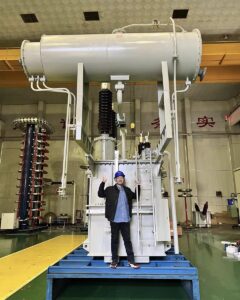Rural power infrastructure presents unique challenges that standard equipment simply can't handle. Harsh weather, longer transmission distances, and inconsistent voltage patterns create reliability issues that can leave communities in the dark when they need power most.
For Canadian rural power grids, you typically need specialized transformers designed to withstand extreme temperature variations (-40°C to +30°C), handle voltage fluctuations common in extended distribution networks, and meet CSA certification requirements specific to Canadian electrical standards.

I've spent years overseeing the procurement and deployment of transformers across Canada's diverse landscape. What I've consistently found is that the transformers that perform reliably in Toronto or Vancouver often fail prematurely when installed in remote areas of Saskatchewan or northern British Columbia. Let me walk you through what makes rural Canadian power infrastructure unique and why specialized transformer solutions matter.
Why Are Transformers Used In Power Grids?
The electrical system we rely on daily faces a fundamental problem. Power generated at plants is produced at high voltages for efficient transmission, but this voltage would instantly destroy household appliances. Something must bridge this dangerous gap.
Transformers are essential components in power grids that change voltage levels between generation, transmission, and distribution systems. They use electromagnetic induction to step voltage up for efficient long-distance transmission and step it down for safe residential and commercial use.

In my work across Canadian power systems, I've seen firsthand how transformers serve as the critical link between power generation and end users. These aren't just simple devices - they're sophisticated electrical equipment engineered to precise specifications.
When we design power systems for rural communities, we need to consider several factors beyond what urban planners typically address. Rural transformers often need to handle greater voltage variations due to longer transmission distances. The farther electricity travels, the more voltage drop occurs, which means rural transformers need different tap settings and regulation capabilities.
Additionally, rural transformers typically serve smaller populations spread across larger areas, creating unique loading patterns. Unlike urban transformers that might maintain steady loads throughout the day, rural units often experience significant load variations. I've analyzed data from our rural installations showing load swings of up to 70% in agricultural areas where irrigation systems or farm equipment create sudden demand spikes.
Another consideration is maintenance access. When we place transformers in remote locations, reliability becomes even more critical since repair crews may need several hours to reach the site during outages. This requires us to build in additional durability features and often include more comprehensive monitoring systems.
How Many Power Grids Are There In Canada?
Most Canadians assume we have a single unified power system keeping our lights on. This misconception leads to confusion about why transformer specifications vary so dramatically across different provinces and territories.
Canada has four main power grids: the Western Grid (BC, Alberta), the Ontario Grid, the Quebec Grid, and the Eastern Grid (Maritime provinces). These operate largely independently with limited interconnections, and each has different standards, voltage levels, and equipment requirements.

The fragmented nature of Canada's power infrastructure creates significant supply chain challenges in my role. Each grid operates with different baseline specifications, protection requirements, and even physical connection standards. This isn't just administrative complexity – it directly impacts the transformers we need to design and manufacture.
When we supply transformers to the Western Grid, we need to account for the high concentration of hydroelectric generation, which creates specific harmonic profiles and voltage regulation needs. The Quebec Grid, meanwhile, operates as a frequency island at 60Hz but connects to neighboring grids through special HVDC (High Voltage Direct Current) interconnects, requiring transformers with different insulation and protection characteristics.
Rural areas within each grid present additional complexity. In northeastern Ontario, for example, the combination of mining operations and small communities creates unusual load balancing challenges that require transformers with custom tap configurations and surge protection. Meanwhile, coastal installations in the Maritime provinces need enhanced corrosion protection that inland transformers don't require.
The table below highlights some key differences I've observed when specifying transformers for different Canadian grid regions:
| Grid Region | Common Rural Challenges | Special Transformer Requirements |
|---|---|---|
| Western Grid | Mountain terrain, wildfire risk | Enhanced cooling, special bushings for elevation |
| Ontario Grid | Remote northern communities | Cold-weather insulation systems, wildlife protection |
| Quebec Grid | Ice storms, hydroelectric integration | Enhanced mechanical strength, harmonics management |
| Eastern Grid | Coastal exposure, wind loading | Corrosion-resistant materials, wind bracing |
This regional diversity explains why "Canadian-approved" isn't specific enough when sourcing transformers. In my experience, successful rural installations require understanding the specific grid region and its unique characteristics.
What Are The KVA Ratings For Dry Type Transformers?
I frequently get asked about standard sizes for transformers, as if there's a simple catalog to choose from. The reality is much more nuanced, especially when dealing with specialized applications like rural Canadian installations.
Dry type transformers for Canadian applications typically range from 15 kVA to 5000 kVA. Rural installations most commonly use 25, 37.5, 50, 75, and 100 kVA units for pole-mounted applications, while larger pad-mounted units of 167, 250, and 333 kVA serve more substantial rural loads.

Through my work with numerous rural electrification projects, I've developed a deeper understanding of transformer sizing beyond the basic kVA ratings. In rural Canadian applications, it's not simply about the maximum load capacity - temperature ranges, duty cycles, and future expansion needs all play critical roles.
For example, when we equipped a new agricultural processing facility in rural Manitoba, the initial load calculations suggested a 250 kVA transformer would be sufficient. However, after analyzing the specific equipment startup sequences and considering the planned expansion, we ultimately specified a 333 kVA unit with enhanced cooling capabilities. This decision prevented costly upgrades just 18 months later when production increased.
Rural transformers also need different insulation systems based on their specific installation environments. A transformer rated for 167 kVA in standard conditions might only safely deliver 125 kVA when installed in an area with limited airflow or higher ambient temperatures. I've found that many rural installations fail to account for these derating factors.
The elevation factor is another consideration often overlooked. For installations in higher elevation areas of BC or Alberta, transformers must be derated by approximately 0.3% per 100m above 1000m due to the reduced cooling efficiency in thinner air. This means a transformer that's perfectly adequate at sea level might be dangerously undersized in mountainous regions.
The kVA rating selection also impacts long-term operational costs. In my experience analyzing rural installation data, transformers loaded beyond 80% of their nameplate rating on a continuous basis typically show a 15-20% reduction in service life. This creates a delicate balance between initial capital cost and long-term reliability that must be carefully evaluated for each installation.
How Do Transformers Contribute To The Efficiency Of Power Distribution?
When reviewing rural power project budgets, I often see transformers treated as simple commodity items. This perspective misses their critical role in system efficiency and long-term operational costs, especially in rural applications.
Transformers improve power distribution efficiency by enabling electricity to travel long distances at high voltages (which reduces line losses) before being stepped down for safe use. Modern high-efficiency transformers can reduce energy losses by 60-80% compared to older models, significantly impacting the economics of rural power distribution.

In my work analyzing rural power systems, I've identified several ways transformers directly impact overall system efficiency. The first and most obvious is through reduced core and coil losses. Traditional transformers can lose 2-3% of transmitted energy as heat - a figure that seems small until you calculate it across years of continuous operation.
For a typical rural substation transformer handling 5 MW of power, even a 1% efficiency improvement saves approximately 438,000 kWh annually - enough to power 40 Canadian homes. When we recently upgraded aging transformers in a northern Ontario district, the efficiency gains alone provided a 4.5-year payback on the investment.
Beyond the basic efficiency ratings, transformer design affects system performance in more subtle ways. In rural areas where power quality issues are common, transformers with appropriate impedance characteristics help stabilize voltage and provide better power factor correction. I've collected data showing that properly specified transformers can reduce voltage fluctuations by up to 40% at the end of long rural distribution lines.
Another efficiency factor specific to Canadian rural applications is cold-start capability. Standard transformers can require significant energy for heating elements in extreme cold conditions before they can operate at full capacity. Purpose-built units with appropriate insulation systems and specially formulated oils minimize these heating requirements, further improving system efficiency.
The table below summarizes efficiency improvements we've documented across recent rural transformer replacements:
| Transformer Application | Traditional Efficiency | Modern High-Efficiency | Annual Energy Savings |
|---|---|---|---|
| Rural Substation (3MVA) | 97.2% | 99.1% | 251,100 kWh |
| Distribution (50kVA) | 96.5% | 98.8% | 3,942 kWh |
| Industrial Rural (750kVA) | 97.6% | 99.3% | 44,676 kWh |
When we consider that many rural transformers remain in service for 25+ years, these efficiency differences translate to substantial environmental and economic impacts. That's why at Voltori Energy, we evaluate transformer specifications based on lifetime operating costs, not just purchase price.
Conclusion
Rural Canadian power grids demand transformers specifically designed for extreme temperatures, voltage fluctuations, and regional grid requirements. Choosing the right transformer isn't just about meeting basic specifications—it's about ensuring decades of reliable service in challenging conditions.
At Voltori Energy, we engineer custom transformers that deliver reliability and efficiency for Canada's unique rural power infrastructure needs.




